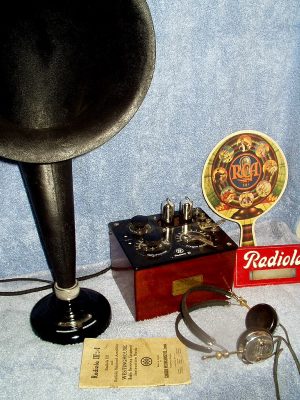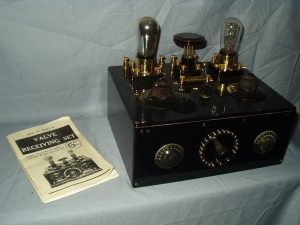 |
| Home |
| History and Background |
| 1920's radios, page 1 |
| 1920's radios, page 2 |
| 1920's radios, page 3 |
| 1920's radios, page 4 |
| 1920's radios, page 5 |
| 1920's radios, page 6 |
| 1920's radios, page 7 |
| 1920's radios, page 8 |
| 1930's radios, page 1 |
| 1930's radios, page 2 |
| 1930's radios, page 3 |
| 1930's radios, page 4 |
| 1930's radios, page 5 |
| 1930's radios, page 6 |
| 1930's radios, page 7 |
| 1930's radios, page 8 |
| 1930's radios, page 9 |
| 1930's radios, page 10 |
| Camera album, page 1 |
| Projector album, page 1 |
| Sewing machine album, page 1 |
| Magic lantern album, page 1 |
| Contact Me |
|
|
 |
|

|
 |
|
I have finally decided to share some of my radio, camera, projector, magic lantern collections with the
rest of the world. All shown are in actual working condition. Haven't gotten around to restoring the outsides
of some stuff, but the works are all operational. Started collecting cameras about 20 years ago when my grandmother
gave me an old Kodak Brownie camera that still had film in it (still have that one), and the collection was started.
At this time, have about 400 cameras (still and movie). Started collecting projectors about 5 years ago while looking
for cameras, and that collection grew as well. Now have about 100 projectors. Also have vintage movie screens,
films (have a bunch of 16mm Charlie Chaplin films), splicers, lenses, ect. That is kind of how I got interested
in radios. Was looking for Victor projectors and came across an RCA Victor antique radio, and soon that collection was
off to a roaring start. Have about 175 radios in my collection at this time.
|
 |
|
Although all radios work now (and some are daily users!) and some are cosmetically restored, they
are usually pretty much train wrecks when I get them. Can get them much cheaper that way, as restored or mint ones are
usually VERY high priced, and after all, I am a low-budget collector. I always replace capacitors (and sometimes resistors
and/or wiring) on every radio I aquire, no exceptions. Same with the power cord. This precludes setting fires to
me, my cat Socrates (who likes to watch me work, and tries to help now and then), the curtains, the carpet, and my workbench
when I turn them on for the first time. I get zapped enough as it is. I have a few pages of some radios, cameras,
and projectors undergoing restoration.
I am still building this web-site, so there will be be blank pages or not-full pages here and
there in here. Still don't have pictures of my cameras or projectors uploaded yet, but will get to it real soon.
I have to borrow a digital camera for all of this as I haven't caught up with the 21st century and bought one yet.
All cameras, projectors, and magic lanterns are in working order, and are actually used from time to time.
Some of my friends like to come over and watch a Charlie Chaplin film or two, or I'll fire up one of the magic lanterns
and put on a slide show (sounds boring, but you would be surprised; it's not your typical parents' vacation slide show).
There are a few people I wish to thank concerning my radios:
First and foremost, Dave and Babylyn Cantelon of "Justradios.com" up in Scarborough, Ontario, Canada. If not for
their schematics, capacitors, and advice, very, very few, if any, of my vintage radios and televisions would be working.
I have depended on them for EVERY tube radio and television in my collection. They were also kind enough to
place my web-site on their links page without my even asking them. Very nice people.
Next would be Leonard "Swede" Bonser of "Tingstad's Radio and Television Repair" in Everett, WA. He's in his late
70's now and is going to close shop in early 2007, but if not for him, some very problematic radios (about 60% of my collection,
actually) would only be doorstops or boat anchors now. I will really, really miss his shop. Sure have learned
a lot from him as well. I actually consider him a good friend.
Mike Tobin of "Rock-Sea Enterprises" in Ojai, CA for his decals and dial scales. He just sold his business
to Radio Daze out of NY (I get a lot of radio parts from them, too), so hope they are as good as Mike was. Mike has
moved, but will be doing very limited custom dial scale work in the future.
John Okolowicz of "Grillecloth.com". About 90% of my radios either had rotted or missing grillecloths, and
John's grillecloths saved my bacon every time.
Gary B. Schneider of "Playthings of the Past" in Medina, OH. Many of my 1920s tube radios and speakers needed
parts that are now extremely hard to find. Like transformers, rheostats, cloth-covered speaker cords, dials. You
name it, he has it. This is probably the only place on the planet I could get some of this stuff.
Buford and Jane Chidester, for their beautiful reproduction cones for my cone speakers. Only place on Earth where
I can find them.
eBay, for all the stuff I couldn't find locally. Antique radio parts, manuals, and schematics from all over
the world is now at my fingertips. Welcome to the 21st century, Mike Morando!
And to all of my relatives and friends who actually put up with my ideosyncracies.
There are other people I wish to thank, and will add them in here as I continue to build this site.
|
|
 |
|

My Canadian Westinghouse Radiola III with original instructions, ca. 1924, an RCA Radiola UZ-1325 speaker, also
ca. 1924, and headphones by Brandes, ca. 1920's, all in great working condition (I actually use this setup from time to time
to listen to baseball games). Some Radiola advertising items also shown: RCA Radiola fan and a Radiola store price
display, both ca. 1920's. None of this stuff was in very good condition when I got them. Pretty nice now, huh?

Here is a little British wireless set you may never see again! Lots and lots of very shiny brass (every single
metal part!)! Believe it or not, I built it using plans from a British book originally published in 1920 (the book I
have is a recent reprint from www.doak.biz). And, yes, this is the very first tube radio I ever built. And, yes,
it does work! Very well, in fact. Next to the receiver is the book I used. Although the schematics
specify British tubes, I used an antique UX-200A tube for the detector, and an antique UX-201A tube for the amplifier instead.
The little "flying saucer" between the tubes is in fact a high-frequency transformer that I made using black plexiglas, brass
rod, #38 magnet wire, and the base from an old dud UX-199 tube. All other parts are genuine early 1920's except
the transformer, the English Walnut wood case, and the two panels (black plexiglas). So, that's how they built
them back then, huh? Took about 1 1/2 weeks of my spare time to make it. The hard part was rounding up all of
the antique radio parts and the double cotton covered wire to wind the coil.
|
 |
|
|
|
|
|
Please let me know what you think of my collection and site!
|
|
|
 |

